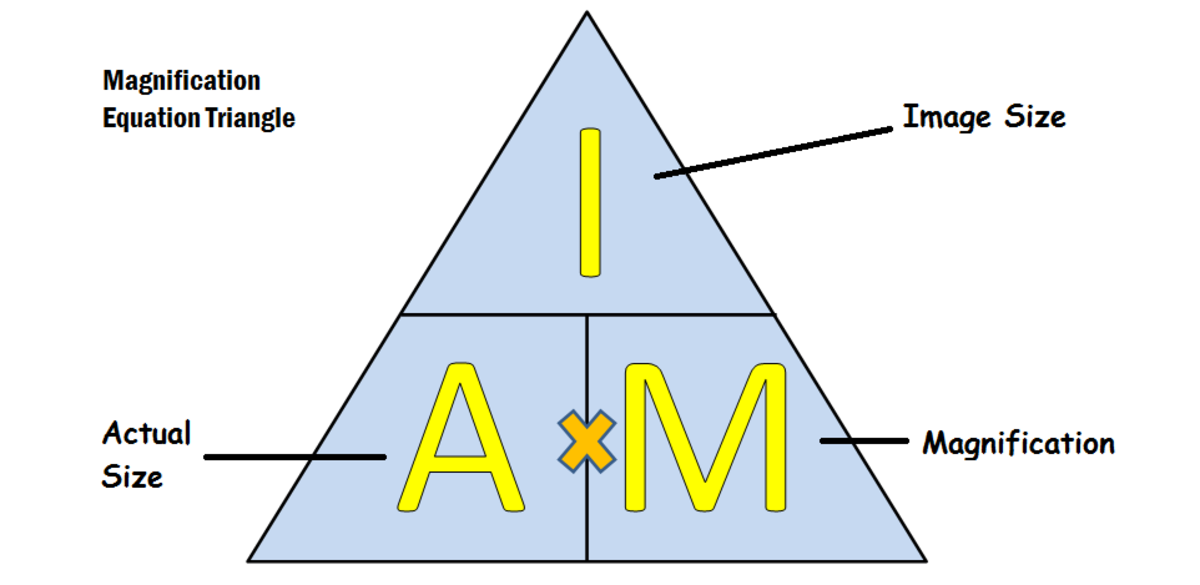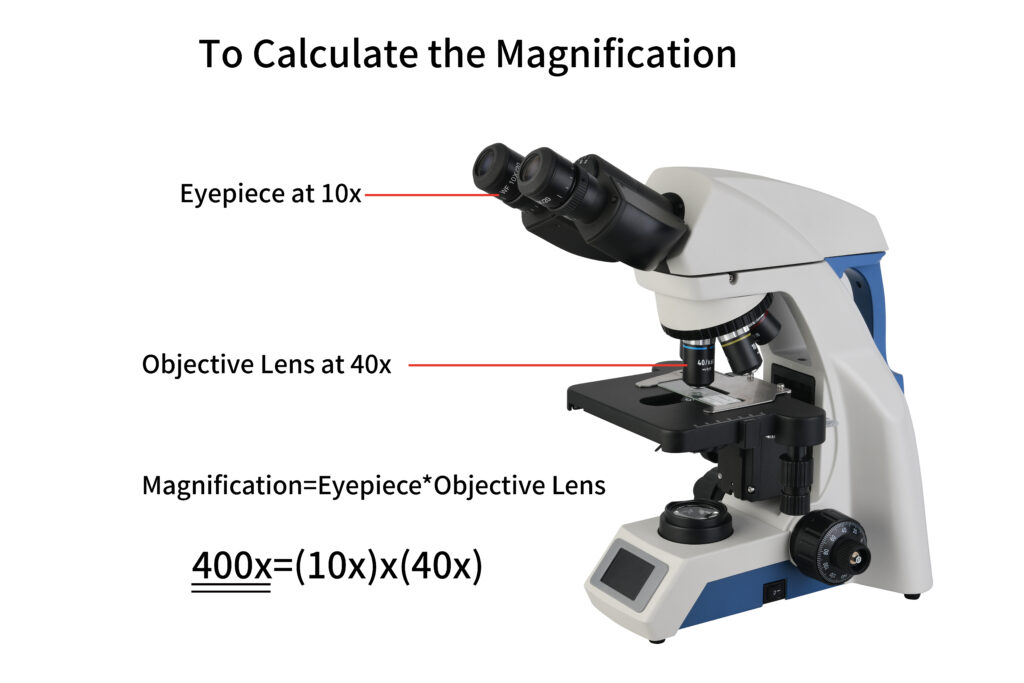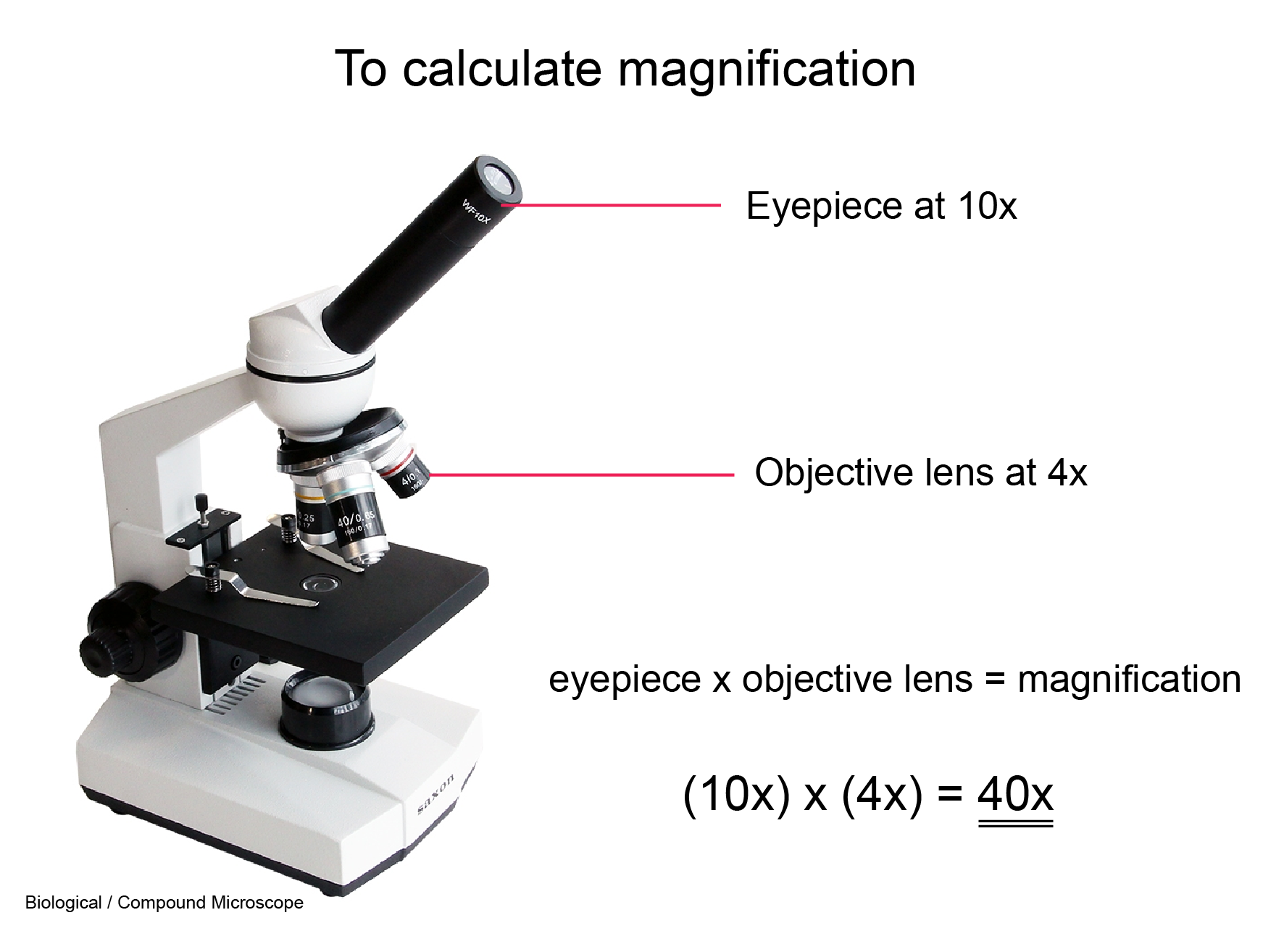Microscope Measurement презентация онлайн

To find the magnification of the ocular lens, divide the distance from the ocular lens to the eyepiece by the diameter of the ocular lens. If the diameter of the ocular lens is 40mm, the magnification value is 1.6x. When using the above formula, remember to multiply both values together to get the total magnification figure.
Compound Light Microscope Magnification Calculation Shelly Lighting

To calculate total magnification, you need to know the magnifications of both the ocular lens and objective lens being used. These values are often printed or engraved on both lenses. For example, an ocular lens may be marked as "10X," indicating 10 times magnification. Similarly, an objective lens may be labeled as "40X," indicating a.
CalcVerter Magnification Calculator Microscope Telescope Optical Image
The purpose of a microscope is to create magnified images of small objects, and both lenses contribute to the final magnification. Also, the final enlarged image is produced sufficiently far from the observer to be easily viewed, since the eye cannot focus on objects or images that are too close (i.e., closer than the near point of the eye).
Microscope World Blog How to Calculate Stereo Microscope Magnification

The magnification of a microscope describes the increase in apparent size of an object compared with its actual size. An object magnified 10 times (10X) appears 10 times larger than it really is. Total magnification is the product of the ocular lens magnification and the objective lens magnification. Magnification does not describe the quality.
Calculating Size of Specimen & Magnification YouTube

Based on the chart above we would calculate digital magnification by using 482.6mm / 8.00 = 60.325. Now we can find the total on-screen magnification by multiplying optical magnification x digital magnification. In our example 2 x 60.325 = 120.65x on-screen magnification.
How to calculate Magnification of Microscope using Magnification Equation Triangle? YouTube

Video transcript. we have a compound microscope whose objective focal length is 5 millimeters eyepiece focal length is 2 and 1/2 centimeters a sample is kept at 6 millimeters from the objective find the magnifying power of this microscope if the final image is formed at infinity let's quickly draw our compound microscope it consists of two.
Types of Microscopy Owlcation

Magnification can be calculated using a scale bar. This is a line drawn near the photograph or drawing which has a label showing the actual length of the bar before being magnified. Working out.
ALevel Biology Linear Magnification

The magnification of a microscope can be calculated using the following formula: Total Magnification = Objective Power x Eyepiece Power Enter Objective Power: x Enter Eyepiece Power: x Calculate Reset The objective lens is the lens closest to the object being viewed, and the eyepiece lens is the lens closest to the eye of the observer.
How to Calculate Total Magnification on a Compound Microscope YouTube

To calculate the magnification on a microscope multiply the magnification power of the eyepiece you are using by the objective currently in position. Magnification = Eyepiece Magnification X Objective Magnification Microscopes magnify or enlarge the image under inspection and enables the human eye to see things we would never be able to see.
Calculating sizes using magnification YouTube

The calculator determines the microscope magnification from the known magnification of the objective lens and the eyepiece (ocular) lens. It also determines the magnification of a microscope with a digital camera and a camera relay lens. Example: Calculate the magnification of a microscope with a 10× ocular lens, a 40× objective lens, and a.
How to Calculate the Magnification of a Microscope?

The objective lens system is found attached to a rotating nosepiece (Fig. 2, part 2). A microscope usually has three or four objectives that differ in their magnification and resolving power. Magnification is the apparent increase in size of an object. Resolving power is the term used to indicate the ability to distinguish two objects as separate.
Compound Light Microscope Magnification Calculation Shelly Lighting

To calculate the magnification of this microscope, you multiply the magnification of the ocular lens by the magnification of the objective lens: Magnification = 10 x 20. Magnification = 200x. So, these are few examples of how to calculate magnification of a microscope. You can apply the same steps while calculating the magnification of any.
Calculating magnification YouTube

An object's magnification is generally given by the equation M = (hi/ho) = - (di/do), where M = magnification, h i = image height, h o = object height, and d i and d o = image and object distance. Method 1 Finding the Magnification of a Single Lens Download Article
Calculating total magnification YouTube

To calculate total magnification, find the magnification of both the eyepiece and the objective lenses. The common ocular magnifies ten times, marked as 10x. Standard microscope objective lenses magnify 4x, 10x and 40x. If the microscope has a fourth objective lens, the magnification will most likely be 100x.
saxon Microscope Buying Guide

Calculate the magnification by multiplying the eyepiece magnification (usually 10x) by the objective magnification (usually 4x, 10x or 40x). The maximum useful magnification of a light microscope is 1,500x. Electron microscopes can magnify images up to 200,000x. Magnification on a Microscope
How to Calculate the Low Power Magnification of a Microscope EstrellahasJarvis

When using a compound microscope, you can calculate the total magnification by multiplying the magnification of the eyepiece by the magnification of the objective lens. For example, if the eyepiece is 10x and the objective lens is 40x, the total magnification would be 400x (10 x 40 = 400).